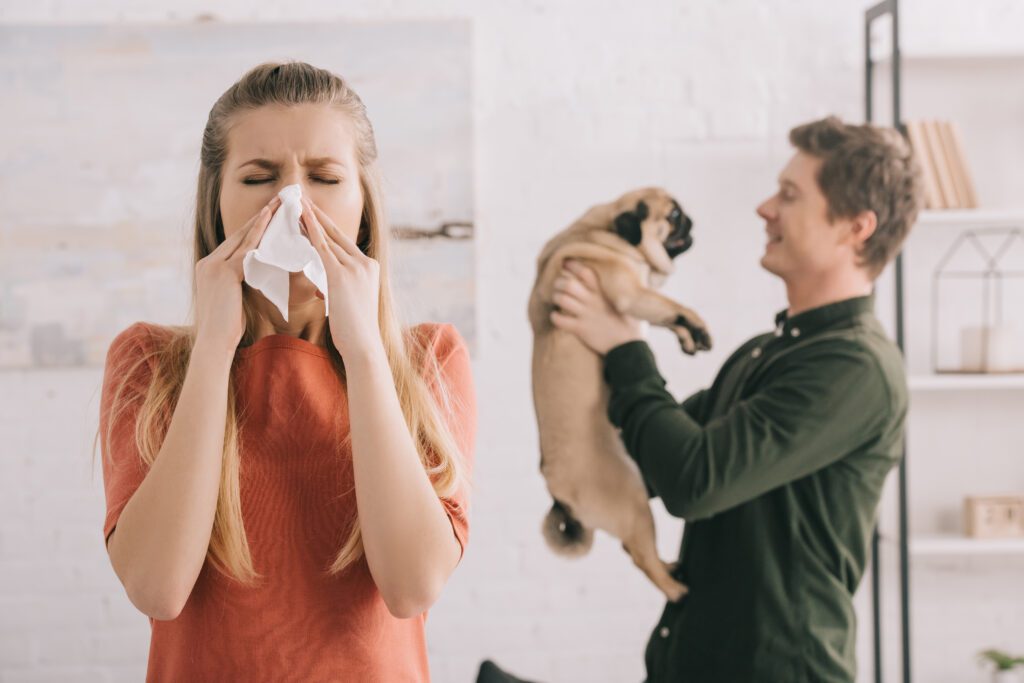Pets bring a lot of joy to our lives, but some people can be allergic to fur-babies. Unfortunately, those allergies keep many from being pet owners and even have some believing they need to get rid of a pet. Luckily, there are numerous ways to live in harmony with a pet if you have non-life-threatening allergies. Take our quiz to learn more.
1. True or false? You should always see your doctor to get an allergy test done if you suspect pet allergies to find out what you are actually allergic to because you may not be allergic to your pet but rather something your pet comes into contact with.
2. Which of the following are common symptoms of an allergic reaction?
A. Itchy, watery eyes.
B. Itchy nose, runny nose, and/or sneezing.
C. Rashes and/or hives.
D. All of the above
3. Which of the following are parts of a pet that may be causing your allergic reaction?
A. Allergy-triggering proteins called allergens in saliva
B. Allergens in skin glands that cling to an animal’s dry skin (dander) and fur
C. All of the above
D. None of the above
4. Which of the following are other things you may be allergic to in addition to, or even instead of, your pet?
A. Pollen
B. Dust mites
C. Cigarette smoke
D. Mold
E. All of the above
5. True or false? A particular dog or cat may cause a more severe allergic reaction, such as one specific cat or dog will cause more (or less!) of an allergic reaction than another animal of that same breed.
6. Which of the following are things you can do in your home to reduce the allergic reaction to a pet?
A. Create an “allergy free” zone area in your home, such as the allergic person’s bedroom, that the pet is not allowed access to.
B. Get rid of dust-and-dander-catching furnishings such as cloth curtains and blinds and carpeted floors.
C. Use HEPA air cleaners throughout the home.
D. Clean frequently and thoroughly to remove dust and dander, including washing cloth items such as couch covers and pillows, curtains, and pet beds.
E. All of the above
7. Which of the following are additional things you can do to reduce allergic reactions to pets?
A. Bathe your pet on a weekly basis to reduce the level of allergy-causing dander, including cats.
B. Reduce the overall allergen level in your home by concentrating on all of the things you’re allergic to, not just the pet allergy.
C. Utilize treatments for allergies.
D. All of the above
8. Which of the following is NOT a treatment for allergies to pets?
A. Immunotherapy, also called allergy shots, which includes giving gradually increasing doses of the allergen to the allergic person to decrease their sensitivity.
B. Antihistamine nose sprays and antihistamine pills, which suppress allergic reactions.
C. Shaving your pet’s fur off.
D. Corticosteroids for allergic reactions, which treat swelling and inflammation from allergies, as well as allergic asthma.
9. True or false? Different breeds of pets may have more or less of an impact on your allergies, such as a dog with soft, constantly growing hair may trigger allergies less than a dog with coarse fur.
10. True or false? Breeds of dogs and cats that are labeled as non-allergenic (don’t cause an allergic reaction) or labeled as hypoallergenic (cause less of an allergic reaction) can still cause a severe allergic reaction.
compiled by ERIKA ALDRICH / information by the Humane Society of the United States.
ANSWERS
True. You can be allergic to many different things.
D. All of the above.
C. All of the above.
E. All of the above.
True. A particular animal may cause more of an allergic reaction than another of the same breed.
E. All of the above.
D. All of the above.
C. Shaving your pet’s fur off. This will not reduce allergens from saliva and is likely not something your pet would enjoy.
True. Different types of fur can cause different levels of allergic reaction.
True. A certain animal may cause more of an allergic reaction than another of the same breed.
